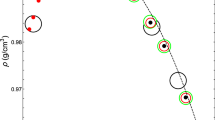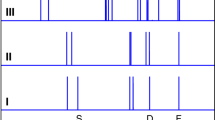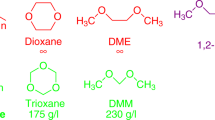Abstract
IN a study of the molecular composition of water vapour we have compared absorption measured at a wave number of about 7 cm−1 with that predicted for vapour consisting only of single molecules. The 7–10 cm−1 spectral region lies between monomer rotation lines where predicted absorption is low, but where anomalies in the absorption spectrum of the atmosphere require explanation1–4. In this experiment a large excess absorption with a quadratic pressure dependence was observed and this is attributed to the presence of water dimers. However, the temperature dependence of the excess absorption at low temperatures is much stronger than that expected from equilibrium concentrations of dimers.
This is a preview of subscription content, access via your institution
Access options
Subscribe to this journal
Receive 51 print issues and online access
$199.00 per year
only $3.90 per issue
Buy this article
- Purchase on Springer Link
- Instant access to full article PDF
Prices may be subject to local taxes which are calculated during checkout
Similar content being viewed by others
References
Emery, R. J., Moffat, P., Bohlander, R. A. & Gebbie, H. A. J. atmos. terr. Phys. 37, 587–594 (1975).
Moffat, P., Bohlander, R. A., McCrae, W. R. & Gebbie, H. A. Nature 269, 676–677 (1977).
Nolt, I. G., Martin, T. Z., Wood, C. W. & Sinton, W. M. J. atmos. Sci. 28, 238–241 (1971).
Harries, J. E. & Ade, P. A. R. Infrared Phys. 12, 81–94 (1972).
Knudsen, V. O. J. acous. Soc. Am. 5, 126–138 (1831).
Becker, G. E. & Autler, S. Phys. Rev. 70, 300–307 (1946).
Gibbons, G. Avalanche Diode Microwave Oscillators (Clarendon, Oxford, 1973).
Lamb, W. E. Phys. Rev. 70, 308–317 (1946).
Gross, E. P. Phys. Rev. 97, 395–403 (1955).
Zhevakin, A. A. & Naumov, A. P. Izv. Vyssh. Ucheb Zaved Radiofiz. 6, 674 (1963).
Emery, R. J. Appl. Opt. 7, 1247 (1968).
McClatchey, R. A. et al. AFCRL Atmospheric Absorption Line Parameters Compilation, AFCRL-TR-73-0096 (1973).
Benedict, W. S. & Kaplan, L. D. J. quant. Spectrosc. Radiat. Transfer 4, 453–469 (1964).
Dill, J. D., Allen, L. C., Topp, W. C. & Pople, J. A. J. Am. chem. Soc. 97, 7220–7226 (1975).
Diercksen, G. H. F., Kraemer, W. P. & Roos, B. O. Theoret. chim. Acta (Berl), 36, 249–274 (1975).
Curtiss, L. A. & Pople, J. A. J. molec. Spectrosc. 55, 1–14 (1975).
Bohlander, R. A. & Gebbie, H. A. Nature 253, 523–525 (1975).
Llewellyn-Jones, D. T., Knight, R. J. & Gebbie, H. A. J. Phys. E 9, 690–692 (1976).
Author information
Authors and Affiliations
Rights and permissions
About this article
Cite this article
JONES, D., KNIGHT, R. & GEBBIE, H. Absorption by water vapour at 7.1 cm−1 and its temperature dependence. Nature 274, 876–878 (1978). https://doi.org/10.1038/274876a0
Received:
Accepted:
Issue Date:
DOI: https://doi.org/10.1038/274876a0
This article is cited by
-
Observation of a strong inverse temperature dependence for the opacity of atmospheric water vapor in the MM continuum near 280 GHz
International Journal of Infrared and Millimeter Waves (1990)
-
Excess attenuation of millimeter waves at window region due to atmospheric water vapor
International Journal of Infrared and Millimeter Waves (1986)
-
Field and laboratory experiments on the 8 to 14 ?m spectral window of the terrestrial atmosphere
International Journal of Infrared and Millimeter Waves (1986)
-
Measurments of attenuation and refractive dispersion due to atmospheric water vapor at 80 and 240 GHz
International Journal of Infrared and Millimeter Waves (1985)
-
Humidity dependence of the atmospheric absorption coefficient in the transparency windows centered at 0.88 and 0.73 MM
International Journal of Infrared and Millimeter Waves (1985)
Comments
By submitting a comment you agree to abide by our Terms and Community Guidelines. If you find something abusive or that does not comply with our terms or guidelines please flag it as inappropriate.



